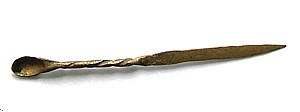
Cleanliness
& Hygiene Tools
HAND WASHING -
SOAP - DEODORANT
MIRRORS - EAR SCOOPS - TWEEZERS
 The
general standard of medieval cleanliness was considerably higher
than Hollywood movies would have us believe. The
general standard of medieval cleanliness was considerably higher
than Hollywood movies would have us believe.
The poorer person was just
as concerned with personal hygiene and cleanliness as the wealthy,
perhaps more so.
A person who worked with
animals or out in the fields all day would be more in need to
wash their hands and face before a meal than a person who had
not worked at manual labour. A lack of money and possessions did
not preclude the lowest classes from basic good hygiene.

Hand
washing
Handwashing was a wide
spread occurence in the middle ages. People would wash their hands
and faces upon rising, before meals, at the end of the day, or
arriving at a house after a long journey. The idea that medieval
people were continually grubby and had poor hygiene is a myth.
Washing the
hands could be done with a simple jug and dish, an aquamanile
or a lavarbo. more info to follow
 The
aquamanile seen here in the shape of a dragon is from the Psalter
of Bonmont, 1200s. German, Besançon. Bibliothéque
Municipale, MS 0054, folio 11v. Many of these were ceramic, but
quite a few extant ones survive in brass. The
aquamanile seen here in the shape of a dragon is from the Psalter
of Bonmont, 1200s. German, Besançon. Bibliothéque
Municipale, MS 0054, folio 11v. Many of these were ceramic, but
quite a few extant ones survive in brass.

A Medieval
Home Companion: Housekeeping in the 14th century by Tania
Bayard, from the Goodman of Paris, gives us one of a few
recipes to make water for washing hands at the table.
"To make Water
for washing hands at table: Boil sage, then strain the water
and cool until it is a little more than lukewarm. Or use chamomile,
marjoram or rosemary boiled with orange peel. Bay leaves are
also good."

Soap
Documentation of guilds of soap-producers can be found in Europe
as early as 800 AD although soap as we know it did not come
into widespread use in Europe until during the ninth century.
It is generally accepted that soap was known in England by the
10th century. A record from Richard of Devizes, a monk from
the 12th century makes remark about the number of soap-makers
in Bristol and the smelly nature of their profession. Records
also show a 'sopehouse' at Bishopgate in London in the 15th
century.
Early soaps
were usually made with tallow, ash and beef or mutton fats making
them rather unattractive to look at. Techniques for the production
of soap improved during the next two hundred years but cakes
of soap remained relatively soft. Aleppo soaps were harsher
and black but worked well, even if they didn't smell luxurious.
By the 12th century, hard soap came into use which was said
to be an Arab development later imported into Europe. The best
soaps were known as castile soap having originated in
Castile, Spain, and made using olive oil instead of fats. These
are still available today.

Deodorant
what
do we know of medieval deodorants? still to add

 Mirrors Mirrors
Types of mirrors in the medieval period ranged from gorgeously
carved and ornate ivory to small, pocket sized ones and hand
held ones.
info to
follow
14thC_ivorytracespolychrome_paris0A7278



Ear
Scoops
Ear scoops have appeared in the archaeological record
from early Viking periods to much later post-Tudor times. They
have a rounded tiny bowl on one end and a flat, wider end at the
other. Many of these have a twisted stem which are ornamental.
As far as we can tell, these items were used to clean the ears
of wax, and clean the fingernails of dirt and grime.
They were usually constructed
from brass, copper alloy, with a flat piece of metal and twisted
to make a handle in the middle. They are usually the size of a
woman's little finger.
 Image
shown here is a scoop made from brass from The
Gilbert Collection and is dated to the 14th century. Image
shown here is a scoop made from brass from The
Gilbert Collection and is dated to the 14th century.
Similar in silver can be
found on the Portable Antiquities Scheme database in the 15th
and 16th centuries.

 Tweezers Tweezers
The basic style of
tweezers has not been improved for hundreds of years, because
how can one improve a basic style with performs its function so
perfectly?
Even though
plucking the eyebrows was commonplace for many women, the church
was extremely unhappy about this. In Confessionale, clergymen
are encouraged to ask those who came to confession:
If she has plucked
hair from her neck, or brows or beard for lavisciousness or
to please men... This is a mortal sin unless she does so to
remedy severe disfigurement or so as not to be looked down
on by her husband.
Many books cite small tweezers
made from copper alloy or silver as part of medieval toiletry
sets.
 The
tweezers at left are dated from the 15th century and feature brass
tweezers, an earscoop and a nail pick, all hinged to fold away
when not in use. The
tweezers at left are dated from the 15th century and feature brass
tweezers, an earscoop and a nail pick, all hinged to fold away
when not in use.

Copyright
© Rosalie Gilbert
All text & photographs within this site are the property of
Rosalie Gilbert unless stated.
Art & artifact images remain the property of the owner.
Images and text may not be copied and used without permission.
|